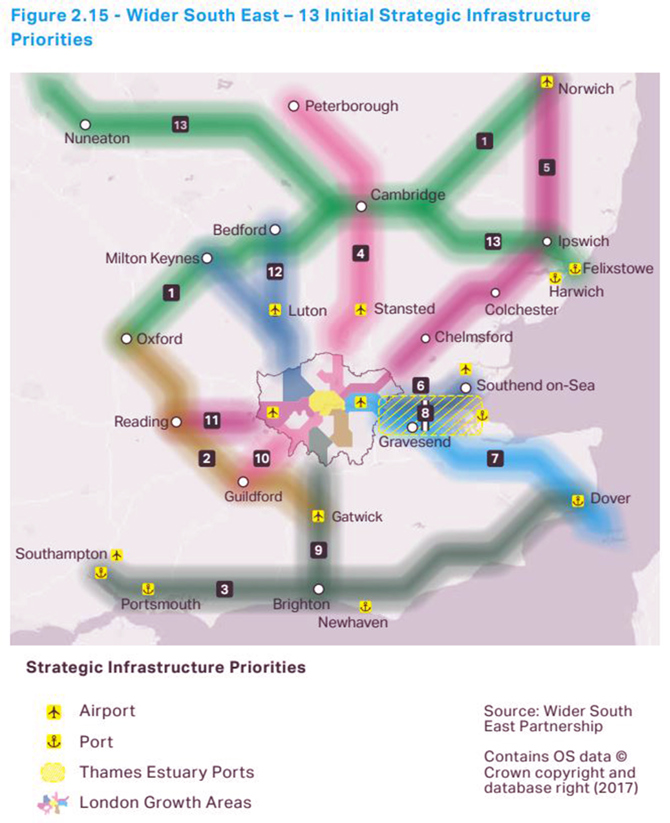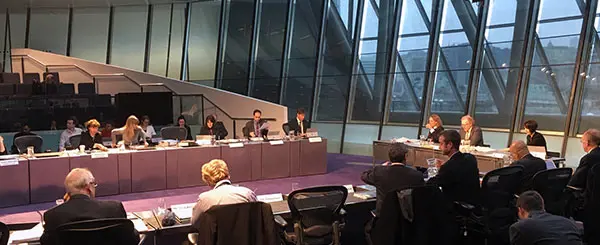Lichfields is currently monitoring the draft London Plan Examination in Public (EiP), which is scheduled to last until May 2019, and will report on relevant updates as part of a blog series. The first blog of the series focuses on the hearing session for M16 ‘Wider South East and beyond’, which took place on 25 January 2019.
The draft London Plan was submitted for Examination in Public (EiP)[i], and is currently being assessed against the policies included in the original NPPF (as per revised NPPF paragraph 214). This means that the Mayor of London does not have to comply with new requirements to prepare Statements of Common Ground for his draft London Plan; he had indeed provided none, despite undertaking informal working with Local Authorities outside London.
Whilst the Greater London Authority’s (GLA’s) current housing need assessment highlights a shortfall of just over 1,000 dwellings per annum (1,065, specifically) when compared to the identified annual housing target (65,000 homes/year), the way the GLA plans to address such shortfall is mostly through further windfall sites rather than through more structured approaches.
Virtually all the participants to the M16 ‘Wider South East and beyond’ hearing session[ii] dismissed this narrow margin – one describing it as ‘the difference between two arbitrary figures’. Others (including the Home Builders Federation) believe that the housing shortfall will be closer to 30,000 dpa in view of the need to double or triple past windfall delivery rates, meaning that additional delivery outside London will be necessary. However, the real battle on housing number will be fought over the next two-three weeks.
During the hearing session, the GLA also referred to the Brandon Lewis’s 2014 letter on Strategic Housing Market Assessments[iii], which recommended Green Belt councils to consider opportunities to collaborate with neighbouring planning authorities to fully meet their housing needs. The former Housing Minister’s letter openly acknowledged the local constraints that affect housing delivery (such as Green Belt), supporting a case-by-case approach and effectively endorsing voluntary strategies to meet additional housing needs between neighbouring authorities.
In London this means that Wider South East (WSE) Local Planning Authorities will be expected to effectively volunteer to meet London’s annual housing shortfall, on top of their own housing needs; the degree of unmet need that each Authority will take would thus come out in the wash rather than be planned for through upcoming EiP discussions. Hence the expression ‘working with willing partners’ as identified through draft Policies SD2-SD3.
Whilst there were a variety of opinions on how to ‘effectively’ deal with such situation, most of the participants to the hearing session felt that a separate South East Technical Secretariat (to include MHCLG, GLA, and WSE Local Authorities) should be established. The Secretariat would be in charge of coordinating the general evidence base collection and assessment for the wider geographical area, while also assisting decision-making by coordinating housing market assessments, land capacity and practical delivery. The EiP Panel was urged to make a side commentary about this potential approach.
At the hearing session it was also highlighted how some Local Planning Authorities are effectively stepping up and coming forward to volunteer as ‘willing partners’; the Oxford/Cambridge Arc Authorities, Waverley, Ipswich and Arun are among these. On the other hand, other local authorities are staying more quiet, such as the Gatwick Diamond ones, in view of the intense local and environmental pressures they are exposed to.

Figure 2.15 of the draft London Plan: ‘Wider South East – 13 Initial Strategic Infrastructure Priorities’
There were also concerns about the ‘Strategic Infrastructure Priorities’ highlighted by the Mayor at Figure 2.15 of the draft London Plan (see Figure above), as linking strategic infrastructure with potential growth areas was considering straying beyond the GLA (and London Plan) remit. Suggestions on this matter focused on the London Plan just indicating certain strategic infrastructure priorities within/outside London, while leaving decisions on housing and employment-related growth to the interested local authorities and/or other strategic bodies.
Finally, few additional takeaway points from the WSE hearing session are listed below:
- Housing intensification was not welcomed by Outer London Authorities, as considered locally undesirable;
- Intensification potential is also considered relatively limited in view of other local pressures;
- The willingness of WSE Authorities to review their green belt land should be matched by a similar commitment in Greater London;
- The draft London Plan should seek to quantify likely housing shortfall and openly address specific Plan review trigger points;
- The urgent need for a new London Plan means that the planning and development sector cannot wait for greater clarity to be provided;
- Some willing partners will come forward, possibly backed by the Growth Fund, but these will need greater support via a more structured and planned Secretariat approach (see above); and
- There is a ‘ripple effect’ risk on house prices expanding from London to the near South East, and then to the Outer South East (and beyond), leading to few people being able to purchase most of the new homes, effectively exporting housing unaffordability.
Lichfields will publish further analysis on the draft London Plan Examination in Public in due course.
Click here to subscribe for updates.
[i] Greater London Authority, Examination in Public for the draft New London Plan
[ii] London Plan Examination in Public: Agenda and Participants, Wider South East and beyond [M16]
[iii] Department for Communities and Local Government, Strategic Housing Market Assessments (December 2014)
This blog has been written in general terms and cannot be relied on to cover specific situations. We recommend that you obtain professional advice before acting or refrain from acting on any of the contents of this blog. Lichfields accepts no duty of care or liability for any loss occasioned to any person acting or refraining from acting as a result of any material in this blog. © Nathaniel Lichfield & Partners Ltd 2019, trading as Lichfields. All Rights Reserved. Registered in England, no 2778116. 14 Regent’s Wharf, All Saints Street, London N1 9RL. Designed by Lichfields 2019




